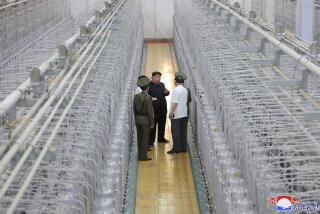U.S. Cool to N. Korea’s A-Plant Proposal : Diplomacy: Perry says offer to allow inspectors to monitor refueling at nuclear reactor does not go far enough.
- Share via
WASHINGTON — The United States reacted cautiously Friday to North Korea’s offer to allow international inspectors to monitor the refueling of its Yongbyon reactor, saying it was not clear they would get enough access to tell whether Pyongyang is building nuclear weapons.
At a press conference Friday, Defense Secretary William J. Perry said the North Korean proposal did not spell out important details about what kinds of conditions might be imposed on the inspectors, such as whether they could take test samples of the spent fuel rods.
The offer came in a letter from Pyongyang to the International Atomic Energy Agency, which conducts the inspections. Agency experts said Friday that they were discussing the offer with North Korean officials over the next few days to iron out the details.
However, in another move in its long-running cat-and-mouse game with the West over the nuclear issue, Pyongyang said it plans to refuel its reactor in May, about two months earlier than expected. Refueling is a critical operation in producing weapons-grade plutonium.
The mid-May refueling is expected to heighten pressure on the West, and could derail a crucial report that the IAEA was scheduled to issue at about that time declaring once and for all whether Pyongyang is complying with its nuclear-inspection obligations.
“We regard that as a step in the wrong direction,” Perry told a press conference in Japan after a week’s visit to discuss the situation in North Korea with his counterparts in Seoul and Tokyo. He returned to Washington late Friday.
Perry said it was critical that the IAEA inspectors be permitted to sample and test the fuel rods that are removed from the reactor because that is the only way they can measure the radioactivity of the spent fuel and determine whether it is being recycled for atomic weapons.
“It’s very clear that the IAEA believes that you need more than just physical presence in Yongbyon,” the site of the reactor, for it to carry out its inspections properly, he told a press conference.
Perry said reprocessing the spent fuel into plutonium, using facilities that North Korea already has constructed, could provide enough fissionable material to manufacture between four and five nuclear warheads.
The defense chief warned that unless North Korea gives IAEA inspectors the free rein they need by the time it begins removing the spent fuel from its reactor, the United States, Japan and South Korea will press for imposition of economic sanctions by the United Nations.
And he said that if the Security Council turns down such a request, the allies might well act on their own.
“I believe we would then seek a way of imposing some sort of international sanctions” outside the U.N. structure, he said.
The Yongbyon facility, which houses a 25-megawatt reactor, was built in 1986, but Western authorities suspect that it may have been refueled clandestinely three years later, with the spent fuel being reprocessed into weapons-grade plutonium.
The CIA has estimated that North Korea may already have manufactured one or two nuclear bombs and is in the early stages of developing longer-range missiles that could deliver nuclear warheads. The refueling planned for May is important to Western authorities because the Yongbyon reactor contains enough spent fuel to enable North Korea to expand a nuclear arsenal substantially.
U.S. officials are worried that if Pyongyang is allowed to expand a nuclear weapons program, it not only will threaten South Korea and Japan, but it may export warheads around the world.
The IAEA demand for access to North Korea’s nuclear plants actually involves three separate parts: The organization wants first to complete the inspections that it began in March, but had to break off because of restrictions that the North Koreas imposed; monitor the refueling at Yongbyon, and visit other nuclear sites.
More to Read
Sign up for Essential California
The most important California stories and recommendations in your inbox every morning.
You may occasionally receive promotional content from the Los Angeles Times.













